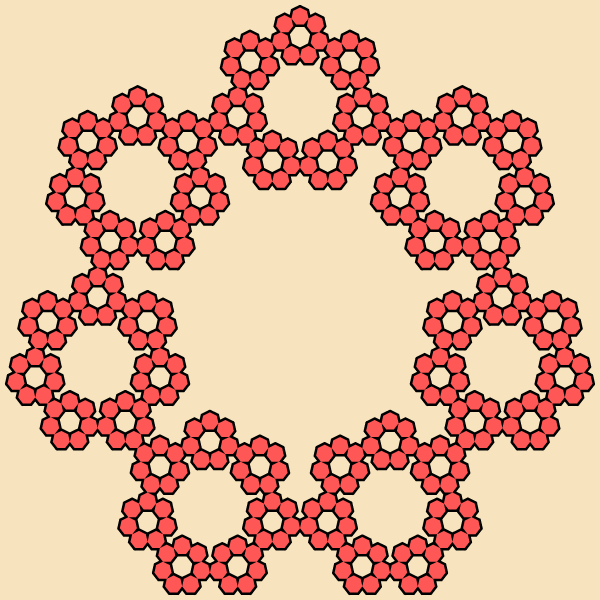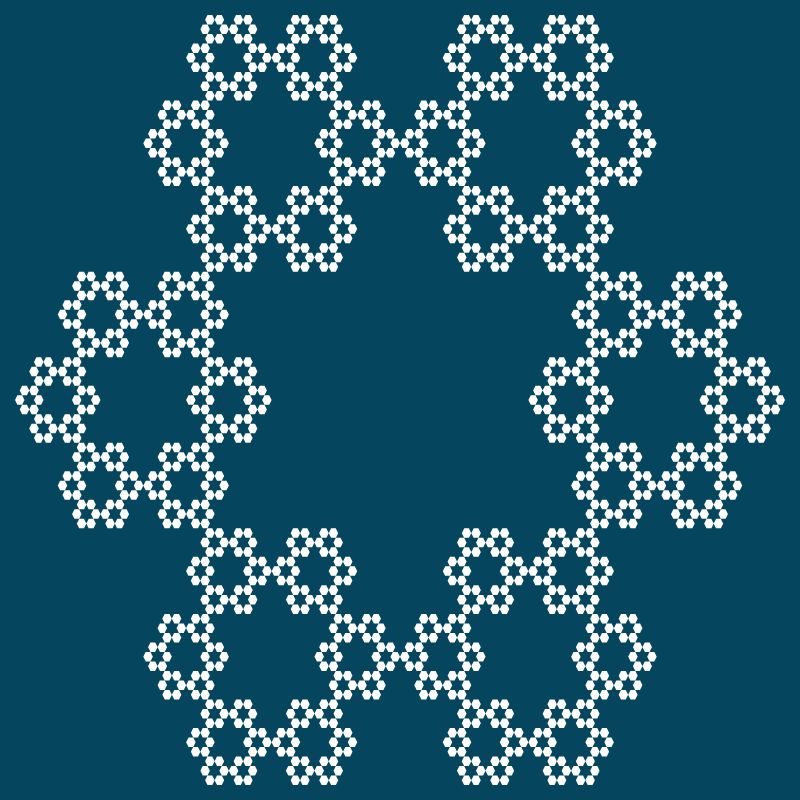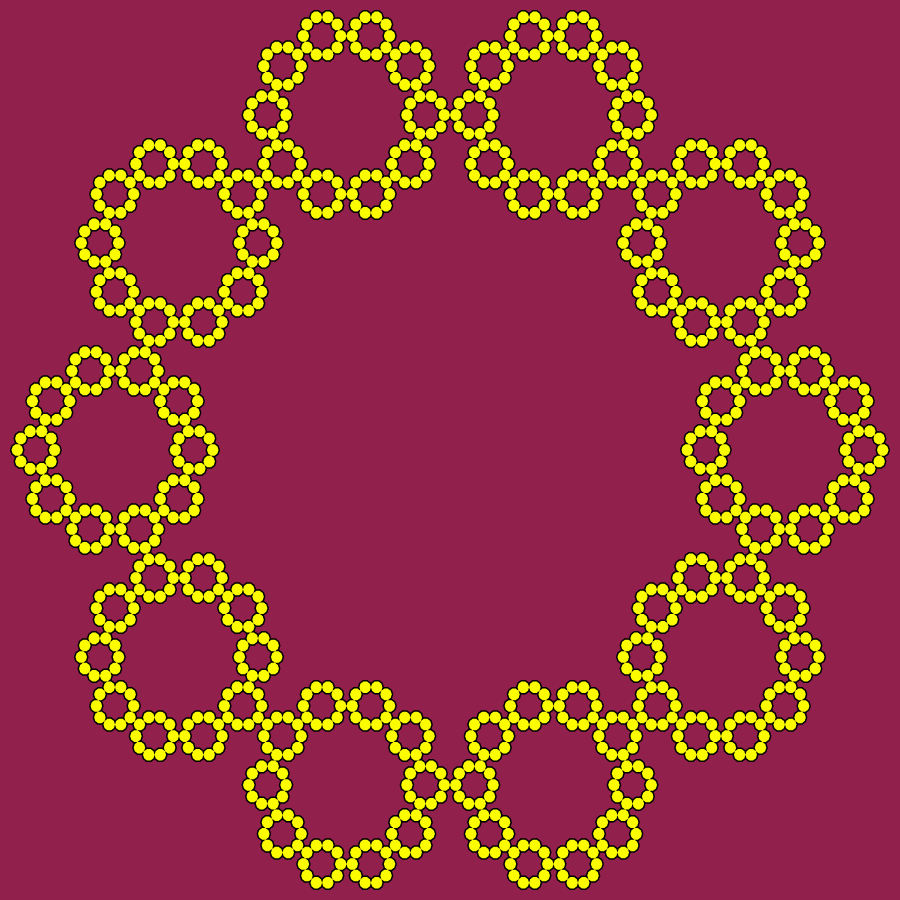This utility lets you draw unique and colorful multiflake fractals. You can choose the number of sides of the initial regular polygon and set the number of subsequent fractal iterations. You can rotate the fractal, as well as adjust the size of the canvas, the thickness of the line that's used to draw polygons, and the padding around the canvas. You can use your own color palette to color the background, line, and interior of polygons. Fun fact – the boundary of the n-gon fractal is the Koch curve with an angle of 180 - α degrees, where α is the internal angle of the n-gon. Created by fractal fans from team Browserling. Fractabulous!
This utility lets you draw unique and colorful multiflake fractals. You can choose the number of sides of the initial regular polygon and set the number of subsequent fractal iterations. You can rotate the fractal, as well as adjust the size of the canvas, the thickness of the line that's used to draw polygons, and the padding around the canvas. You can use your own color palette to color the background, line, and interior of polygons. Fun fact – the boundary of the n-gon fractal is the Koch curve with an angle of 180 - α degrees, where α is the internal angle of the n-gon. Created by fractal fans from team Browserling. Fractabulous!

This online browser-based tool allows you to illustrate the n-fold symmetry of multiflake fractals. A multiflake fractal is sometimes also called a polyflake fractal or just a polyflake for short. This fractal was first studied by a Polish mathematician Sierpinsky, who found the connection between the flakes and Koch curves. As the name suggests, a polyflake fractal starts with a regular n-sided polygon. Then, n copies of this polygon are created, each smaller by a factor proportional to n, and fit into the vertices of the original polygon. This leads us to the second iteration stage of the fractal. To perform the third iteration, we create n copies of the new pattern and repeat the process again. Thus, the number of n-gons at the i-th iteration step is equal to n^(i - 1). As the number of sides of the original flake increases, the fractal evolves to a circle with a massive empty center. In fact, a higher order multiflake contains infinitely many Koch curves, whose angle decreases with increasing values of n. Mind blowing and ingenious at the same time, or as we love to say – fractabulous!
This online browser-based tool allows you to illustrate the n-fold symmetry of multiflake fractals. A multiflake fractal is sometimes also called a polyflake fractal or just a polyflake for short. This fractal was first studied by a Polish mathematician Sierpinsky, who found the connection between the flakes and Koch curves. As the name suggests, a polyflake fractal starts with a regular n-sided polygon. Then, n copies of this polygon are created, each smaller by a factor proportional to n, and fit into the vertices of the original polygon. This leads us to the second iteration stage of the fractal. To perform the third iteration, we create n copies of the new pattern and repeat the process again. Thus, the number of n-gons at the i-th iteration step is equal to n^(i - 1). As the number of sides of the original flake increases, the fractal evolves to a circle with a massive empty center. In fact, a higher order multiflake contains infinitely many Koch curves, whose angle decreases with increasing values of n. Mind blowing and ingenious at the same time, or as we love to say – fractabulous!
In this example, we generate a multiflake fractal with a regular heptagon in the base (hepta means seven). We evolve it for 4 iterations and get a heptagon fractal with 7^(4 - 1) = 343 heptagons. We use a givry color canvas of 600x600 pixels, a black line for the borders of heptagons and a persimmon color for heptagon fill. A heptagon multiflake is also called a Sierpinski Heptagon.
This example puts a regular 6-gon in the base, thus generating the well-known hexaflake fractal. It uses 5 iteration steps here and the image is composed of 6^(5 - 1) = 1296 hexagons. The hexagons are drawn without a border and are only filled with white color.
In this example, we generate a decagon fractal (the base is a ten-sided polygon). As its internal angle is 144° degrees, the Koch curve around it has 180°-144° = 36° degrees. Because of its stunning symmetry, this fractal type is often used to design necklaces. If you count carefully, you'll find there are 10^(4 - 1) = 1000 decagons in this drawing. Decagons are drawn with black ink on a disco-red background and filled with a yellow color.
You can pass options to this tool using their codes as query arguments and it will automatically compute output. To get the code of an option, just hover over its icon. Here's how to type it in your browser's address bar. Click to try!
Walk the Hilbert fractal and enumerate its coordinates.
Walk the Peano fractal and enumerate its coordinates.
Walk the Moore fractal and enumerate its coordinates.
Encode the Hilbert fractal as a string.
Encode the Peano fractal as a string.
Encode the Moore fractal as a string.
Encode the Cantor set as a string.
Encode the Heighway Dragon as a string.
Encode the Sierpinski fractal as a string.
Generate a Sierpinski tetrahedron (tetrix) fractal.
Generate a Cantor's cube fractal.
Generate a Sierpinski-Menger fractal.
Generate a Jerusalem cube fractal.
Generate a Jeaninne Mosely fractal.
Generate a Mandelbrot tree fractal.
Generate a Barnsley's tree fractal.
Generate a Barnsley's fern fractal.
Generate a binary tree fractal.
Generate a ternary tree fractal.
Generate a dragon tree fractal.
Generate a de Rham curve.
Generate a Takagi-Landsberg fractal curve.
Generate a Peano pentagon fractal curve.
Generate a tridendrite fractal curve.
Generate a Pentigree fractal curve.
Generate a lucky seven fractal curve.
Generate an Eisenstein fractions fractal curve.
Generate a Bagula double five fractal curve.
Generate a Julia fractal set.
Generate a Mandelbrot fractal set.
Generate a Mandelbulb fractal.
Generate a Mandelbox fractal.
Generate a Buddhabrot fractal.
Generate a Burning Ship fractal.
Generate a toothpick sequence fractal.
Generate an Ulam-Warburton fractal curve.
Generate an ASCII fractal.
Generate an ANSI fractal.
Generate a Unicode fractal.
Generate an emoji fractal.
Generate a braille code fractal.
Generate a fractal in audio form.
Create a fractal that looks like one but isn't a fractal.
Generate a fractal from any text.
Generate a fractal from a string.
Generate a fractal from a number.
Join any two fractals together.
Create a completely random fractal.
Set up an arbitrary IFS system and iterate it.
Recursively transform an image using IFS rules.
Run infinite compositions of analytic functions.
Create a surface that mimics a natural terrain.
Create a fractal surface via Brownian motion.
Apply fractal algorithms on your image and make it self-similar.
Find fractal patterns in any given image.
Find fractal patterns in any given text.
Find fractal patterns in any given number.
Tessellate a plane with fractals.
Run a cellular automaton with custom rules.
Play Conway's Game of Life on an infinite grid.
Subscribe to our updates. We'll let you know when we release new tools, features, and organize online workshops.
Enter your email here
We're Browserling — a friendly and fun cross-browser testing company powered by alien technology. At Browserling our mission is to make people's lives easier, so we created this collection of fractal tools. Our tools have the simplest user interface that doesn't require advanced computer skills and they are used by millions of people every month. Our fractal tools are actually powered by our web developer tools that we created over the last couple of years. Check them out!




